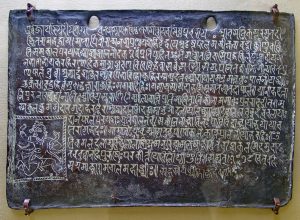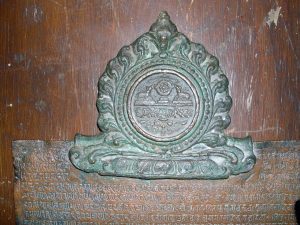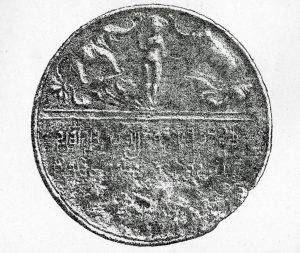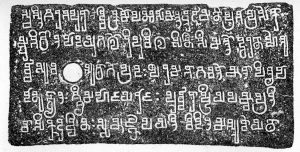IN03216 Laṅkātilaka Copper Plates
This set of four copper plates are preserved in the Laṅkātilaka Temple at Udunuwara in Kandy District. These plates are dated in the seventh year of Rājāhirājasiṁha, who reigned from 1781 until 1798. The fourth plate is inscribed with grants of lands to the temple from this monarch and his predecessor, Kīrtiśrī Rājasiṁha (r. 1747–1781). The first three plates, meanwhile, are engraved with copies of earlier grants to the temple made by kings Bhuvanaikabāhu IV and Vikramabāhu III in the fourteenth century. These grants were originally recorded on a rock to the south of the temple (IN03212 and IN03213). However, there are some discrepancies between the rock inscriptions and the texts engraved on these plates. It cannot simply be the case that the engravers of the copper-plates struggled to decipher the original inscriptions, since the discrepancies affect portions of the text which remain clearly legible on the rock. Certain discrepancies appear to be the result of the eighteenth-century scribes having adapted the fourteenth-century text to match their notions of propriety and to magnify the part of Senā-Laṁkādhikāra in the grant to the temple. Furthermore, Senarath Paranavitana conjectures that the copper plates were not based directly on the rock inscriptions but were instead copied from earlier copper-plate charters, which contained variant versions of the texts. It certainly seems to have been the case that the grants proclaimed in the rock inscriptions were also recorded on copper plates, since the inscription of Bhuvanaikabāhu declares as much.
OB03160 Vallipuram Gold Plate
IN03201 Vallipuram Gold Plate Inscription
This inscription is engraved on a thin gold plate, said to have been discovered – along with other minor antiquities – beneath the foundation of an ancient structure on the lank belonging to the Viṣṇu temple at Vallipuram, a village in the Jaffna District, in or about 1936. On palaeographic grounds, the record can be assigned to the second century A.D. It is dated in the reign of King Vaha and records the establishment of a vihara at a place called Badakara-atana by an individual named Piyaguka Tisa when the Minister Isigiraya was the governor of Nakadiva (Nāgadīpa). The king’s name, written as ‘Vaha’, is probably meant for ‘Vahaba’ (Vasabha), whose reign lasted approximately from 126 to 170 A.D.
Senarath Paranavitana edited and translated the inscription in 1939 (Epigraphia Zeylanica 4, pp. 229–237). However, his translation proved immensely controversial and the plate was drawn into the ethnic conflict in Sri Lanka. Paranavitana described the language of the plate as Siṅhala Prākṛt, which he calls “old Sinhalese”, but subsequent scholars have suggested that it can be read as Prākṛt with a Tamiḻ substratum (Vēluppiḷḷai 1990: 10–42), Prākṛtised Tamiḻ (Nāgacāmi 1994: 220–222) and Paiśāci-Prākṛt (Schalk 1996: 306). Since the text is so short, one can argue for all four possibilities. As Schalk points out, the determination of the language is open to political exploitation, since the different linguistic possibilities can be used to redraw the ethnic identity of the Vallipuram area. If the language is Siṅhala, the inscription can be framed as evidence of a Siṅhala Buddhist tradition in the region, which rationalises Siṅhala settlements in Tamiḻ areas. By contrast, if the language is Prākṛt with a Tamiḻ substratum or Prākṛtised Tamiḻ, it can be mobilised to support the case for autonomous Tamiḻ administration. Hence the inscription was often the subject of what Schalk calls “interested” historical writings during the civil war period (Schalk 1996: 308).
Pipaladā copper plate charter of Bhoja dated VS 1077 and VS 1078

Pipaladā (Indore Tahsil, Indore District, Madhya Pradesh). Copper plate charter of Bhoja. Indore, State Museum.
OB03111 Palkum̆bura Copper Plate of Bhuvanaika Bāhu VII
IN03135 Palkum̆bura Sannasa of Bhuvanaika Bāhu VII
The inscription is engraved on a charred copper plate. When H. W. Codrington recorded the plate was in the third volume of Epigraphia Zeylanica in the 1930s, he noted that it was in the possession of the in the possession of the Palkum̆bura Vihārē in Hārispattuva of the Kandy District. However, the record relates to a different temple. The plate has been badly damaged by fire. It is dated in the reign of Bhuvanaika Bāhu VII and records a grant of land, subject to a payment to Viṣṇu, to the Mahā Thero of the Senevirat-muḷa establishment.
OB03087 Oruvaḷa Copper Plate
IN03107 Oruvaḷa Sannasa
The sannasa (land grant) is engraved on both sides an oblong copper-plate. There are fifteen lines of text on the observe and a further fifteen lines on the reverse. Writing in the late 1920s, Codrington recorded that the plate “has for many years been in the possession of Mr W. P. Ranasinha, Notary Public”. The latter’s son – A.G. Ranasinha Esq., C.M.G., C.B.E. – lent it to an exhibition organised by the Historical Manuscripts Commission in 1952.
The sannasa records a grant of land to two Brahmans – one Potā Ojjhalun and his nephew Avuhaḷa Ojjhalun of the Śān̆ḍiḷya gotra. As the sannasa relates, these Brahmans served as chief purohita “until His Majesty our King Mahā Parākrama Bāhu…had worn the crown fifty-five times” (i.e. had reigned for fifty-five years). Kings of this period wore the state crown every year on the anniversary of their coronation, hence a king who wore the crown fifty-five times must have reigned for fifty-five years. In recognition of their service, the Brahmans received for their maintenance the village of Oruvaḷa in Aturugiri Kōralē. Subsequently another king made this village a perpetual dānakṣetra in favour of the nephew and also granted him another village in the neighbourhood. Avuhaḷa Ojjhalun, not content, applied either to the same king or to one of his successors for a copper-plate charter confirming that the land held by him was permanently declared a dānakṣetra subject to an annual payment of fifteen fanams to the god Vishṇu. In answer to this request, the present sannasa was issued by king Siri San̆gabo Śrī Parākrama Bāhu at Jayavarddhanapura Kōṭṭē in the fourth year of his reign.
Codrington identifies Mahā Parākrama Bāhu – the king served by the two Bhamans – as Parākrama Bāhu VI, who reigned from 1412 (or 1415, according to certain historical sources) until 1467 A.D. However, the identity of Siri San̆gabo Śrī Parākrama Bāhu – the king who issued the sannasa – is less certain. Kings Parākrama Bāhu VII, VIII and IX are all possibilities, although it is most likely to have been one of the first two. On palaeographic grounds, Codrington favours Parākrama Bāhu VIII. Oruvaḷa (Oruwala), the village mentioned in the grant, is situated near Aturugiriya, about three miles south-south-west of Nawagamuwa.
Copper plate of Mahendrapāla from Jagjivanpur জাগ্জিভানপুর
Jagjivanpur জাগ্জিভানপুর (Habibpur block, Malda district, West Bengal).
Copper plate of Mahendrapāla from Jagjivanpur (Habibpur block, Malda district, West Bengal).

OB01012 Arang copper plates of Jayarāja


Arang copper charter of Jayarāja, seal and first plate
